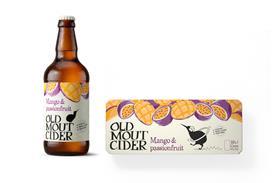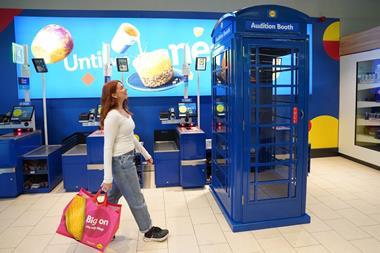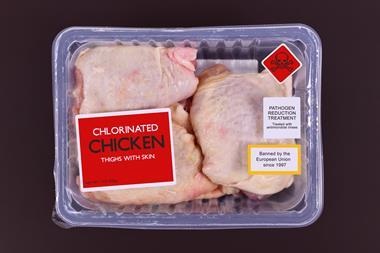There is still plenty to play for in the petfood market for smaller animals such as rabbits and hamsters
Compared with dogs and cats, which remain Britain’s favourite pets, smaller beasts such as hamsters and gerbils come well down the food chain.
Until the late 1990s most supermarkets barely touched the ‘small animal’ sector, leaving it to the specialist pet stores. But according to Tom Page, a director at manufacturer Wagg, despite a slowing of growth in the past 12 months, there is significant scope for grocers in food for hamsters, gerbils, guinea pigs and rabbits.
Hard data is almost non-existent but Page claims this
market has been growing at 10-20% a year “for as many years as anyone can remember” to reach an estimated £13m-£15m in grocery. And with supermarkets and convenience stores currently selling just
10% of all small animal foods, he says there’s a lot to play for - especially as margins can be substantially higher than in the more heavily price-promoted area of catfood and dogfood. Tesco and Morrisons have been particularly strong in small animal food, says Page.
Tesco at one time had an estimated 35-40% of sales through grocery. It recently dropped all branded small animal foods and switched to own label, which Page believes may have caused a short-term sales dip - petfood shoppers will often favour even a tertiary brand over own label, he says - but he expects Tesco to be in growth again this year.
And Morrisons has had a “stellar year” after extending its established small animal range into the former Safeway stores.
“We’ve had a good range of small animal, bird and fish products for
a number of years, which is currently benefiting from an increase in dedicated fixture space,” confirms Morrisons’ senior buyer Linda Whittaker.
In 2003 there were 2.5 million rodent-owning households, according to the Pet Food Manufacturers’ Association, and while it doesn’t have current figures for the total population of small pets, Wagg - whose company is a PFMA member - believes the graph is pointing upwards. “When I talk to companies such as Pets At Home about the number of live pets they’re selling, how many cages and other bits and pieces, then I presume the market is still growing.”
And increasingly, small animals are bucking the image of being children’s pets. Smaller animals
require less space and are generally less demanding than cats and dogs and, for older owners particularly, have the brutally practical advantage of being relatively short-lived.
“A lot more adults will train a rabbit nowadays and keep it indoors,” adds Page.
This is good news, since rabbits are the biggest eaters in the small animal arena, followed by the gluttonous guinea pig. Wagg’s research suggests as many as 50% of small animal owners are adults - and something like 60% also have other pets.
So if grocers can catch these shoppers with rabbit or hamster food, there’s a good chance of selling them dogfood or catfood too, rather than losing them to specialist stores.
He says, however, that grocers prefer to focus on heavily advertised brands. As a result, space given to small animal food can be all but invisible from the end of the aisle.
At the Co-op, category buyer David Hall says the retailer has reduced the space it gives to small animals. However, it is concentrating on getting its core offerings right.
Compared with dogs and cats, which remain Britain’s favourite pets, smaller beasts such as hamsters and gerbils come well down the food chain.
Until the late 1990s most supermarkets barely touched the ‘small animal’ sector, leaving it to the specialist pet stores. But according to Tom Page, a director at manufacturer Wagg, despite a slowing of growth in the past 12 months, there is significant scope for grocers in food for hamsters, gerbils, guinea pigs and rabbits.
Hard data is almost non-existent but Page claims this
market has been growing at 10-20% a year “for as many years as anyone can remember” to reach an estimated £13m-£15m in grocery. And with supermarkets and convenience stores currently selling just
10% of all small animal foods, he says there’s a lot to play for - especially as margins can be substantially higher than in the more heavily price-promoted area of catfood and dogfood. Tesco and Morrisons have been particularly strong in small animal food, says Page.
Tesco at one time had an estimated 35-40% of sales through grocery. It recently dropped all branded small animal foods and switched to own label, which Page believes may have caused a short-term sales dip - petfood shoppers will often favour even a tertiary brand over own label, he says - but he expects Tesco to be in growth again this year.
And Morrisons has had a “stellar year” after extending its established small animal range into the former Safeway stores.
“We’ve had a good range of small animal, bird and fish products for
a number of years, which is currently benefiting from an increase in dedicated fixture space,” confirms Morrisons’ senior buyer Linda Whittaker.
In 2003 there were 2.5 million rodent-owning households, according to the Pet Food Manufacturers’ Association, and while it doesn’t have current figures for the total population of small pets, Wagg - whose company is a PFMA member - believes the graph is pointing upwards. “When I talk to companies such as Pets At Home about the number of live pets they’re selling, how many cages and other bits and pieces, then I presume the market is still growing.”
And increasingly, small animals are bucking the image of being children’s pets. Smaller animals
require less space and are generally less demanding than cats and dogs and, for older owners particularly, have the brutally practical advantage of being relatively short-lived.
“A lot more adults will train a rabbit nowadays and keep it indoors,” adds Page.
This is good news, since rabbits are the biggest eaters in the small animal arena, followed by the gluttonous guinea pig. Wagg’s research suggests as many as 50% of small animal owners are adults - and something like 60% also have other pets.
So if grocers can catch these shoppers with rabbit or hamster food, there’s a good chance of selling them dogfood or catfood too, rather than losing them to specialist stores.
He says, however, that grocers prefer to focus on heavily advertised brands. As a result, space given to small animal food can be all but invisible from the end of the aisle.
At the Co-op, category buyer David Hall says the retailer has reduced the space it gives to small animals. However, it is concentrating on getting its core offerings right.














No comments yet